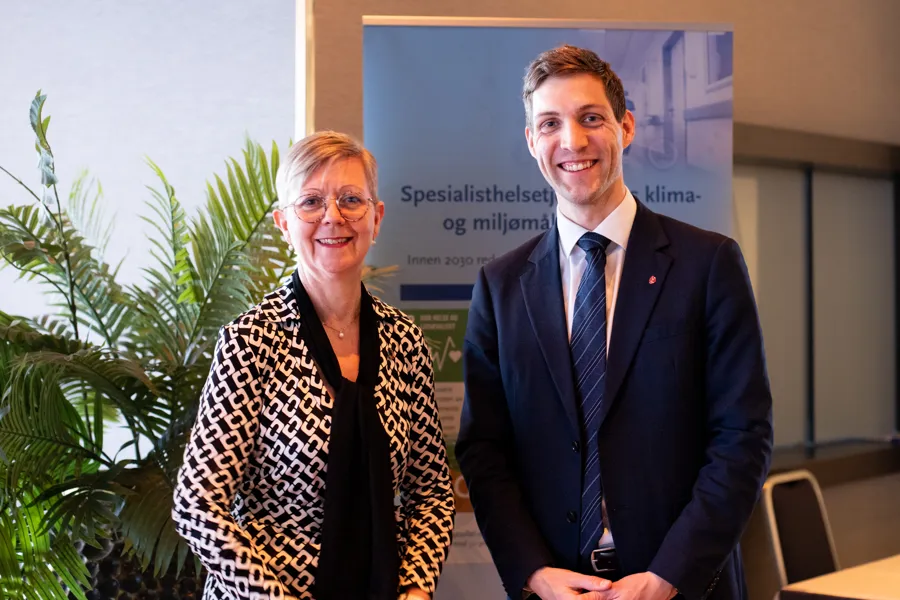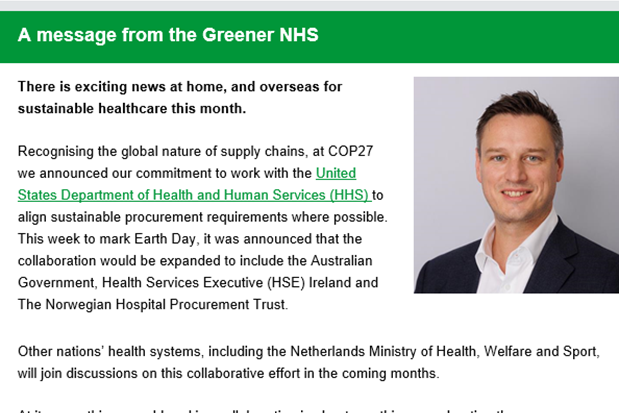Norge inngår samarbeid med Storbritannia og USA om klimakrav i anskaffelser
Norske helsemyndigheter forplikter seg til å følge veikartet til britiske NHS og amerikanske HHS mot et utslippsfritt helsevesen.

Det betyr blant annet strengere krav til utslipp og materialbruk for leverandørene til helsesektoren.
Sykehusinnkjøp HF har går ut med nyheten i forbindelse med Spesialisthelsetjenestens miljø- og samfunnsansvarskonferanse mandag, hvor åpningsdagen i år sammenfaller med Jordens dag (Earth day).
Det internasjonale samarbeidet er en forlengelse av Norges tilslutning til helseprogrammet under klimakonferansen COP26 i Glasgow i 2021.
Rundt 50 land undertegnet denne avtalen. I etterkant har helsemyndighetene i Storbritannia (NHS) og USA (HHS) skissert et veikart for å nå målene – og invitert andre med.
– Det er veldig bra at vi er blant de mest ambisiøse landene på dette området. Alene er Norge en liten aktør på det globale markedet, men når vi går i takt med andre kan vi påvirke markedet i større grad, sier administrerende direktør Bente Hayes i Sykehusinnkjøp.
- Les mer om NHS' miljøarbeid her.
Bruke markedsmakt og samarbeid
En rekke land ser på muligheten for å slutte seg til det britisk-amerikanske initiativet, og norske helsemyndigheter er nå et av tre land som gjør ytterligere forpliktelser. De to andre er Irland og Australia.
Sykehusinnkjøp er oppført som partner i samarbeidet som Norges nasjonale innkjøpsorgan for spesialisthelsetjenesten.
– Denne utfordringen tar vi med glede, og vi ser fram mot å fortsette det viktige miljøarbeidet sammen med våre eiere, de fire helseregionene, sier Hayes.
Helsemyndighetene i samarbeidslandene er tydelige på at de vil bruke markedsmakta de har til å trekke leverandørnæringen i mer miljøvennlig retning.

The Norwegian minister of environment, Andreas Bjelland Eriksen, pictured here with Sykehusinnkjøp director Bente Hayes.
Foto: Ole-Tommy Pedersen
– Storbritannia og USA har gjort veldig mye godt arbeid på dette feltet, og de hatt god dialog med aktørene og bransjeorganisasjonene i helsesektoren. Vi får en stor fordel i at vi ikke trenger å gå opp den samme løypa på nytt, men kan videreføre vår gode dialog med leverandører og innføre vilkår som bransjen allerede har begynt å venne seg til, sier Hayes.
Samtidig har også Helsedirektoratet, på oppdrag fra Helse- og omsorgsdepartementet, utarbeidet et høringsutkast til et norsk veikart mot en bærekraftig, lavutslipps helse- og omsorgstjeneste. Dette er ute på høring fram til 16. mai.
Mest utslipp fram til leveranse
Satsingen retter seg i stor grad inn mot produksjons- og distribusjonsleddet før bestillingene ankommer sykehusene.
For selv om store og ressurskrevende sykehusbygg rundt om i verden har vesentlige utslipp fra blant annet strømforbruk, utgjør den direkte driften bare 20-30 prosent av totalutslippene fra spesialisthelsetjenesten ifølge Health Care Without Harm og Helsedirektoratets vurderinger.
– Vi vet at det største potensialet for utslippskutt ligger i verdikjeden, altså alt vi kjøper inn. Det er her 70-80 prosent av klimagassutslippene skjer, forteller Maiken Pollestad Sele, spesialrådgiver miljø og klima i Sykehusinnkjøp HF.

Allerede i gang
Sykehusinnkjøp HF har gjort anskaffelser med nye miljøkriterier innenfor både legemidler og medisinske produkter som kjøpes inn til norske sykehus. Det bestemte inntrykket er at leverandørene i bransjen har skjønt tegninga og ønsker å gjøre sitt for å nå klimamålene.
– Leverandørene etterlyser nettopp felles internasjonale krav og kriterier. De bruker mye ressurser på omstilling og dokumentasjon, så det er unødvendig at de møtes av vidt forskjellige miljøkriterier fra ulike land eller regioner de skal gi tilbud til, sier Sele.
Og legger til;
– Samtidig gjelder det å finne en fornuftig takt slik at både gigantene i markedet og de mindre leverandørene faktisk har sjanse til å omstille seg. Alt dette er lettere når vi går hånd i hånd med store aktører som NHS og HHS.
Viktig frist i 2027
Arbeidet med NHS Procurement Roadmap er allerede godt i gang og kommunisert ut til bransjen. Et hovedmål er at alle leverandører til helsevesenet innen april 2027 må ha en offentlig tilgjengelig plan for hele produksjons- og fraktkjeden som er i tråd med NHS’ mål for nullutslipp.
For Norge sin del blir det et spørsmål om hvilket nivå av implementering vi skal legge oss på i starten – og etter hvert bli samkjørte med NHS’ framdrift.
– På enkelte områder har Norge også kommet lenger enn andre, som krav til miljømerking og utfasing av kjemikalier i produksjonen. Så vi har også en ambisjon om å få de andre landene i samarbeidet til å følge etter der vi har kommet lengst, sier Sele.
- (PRESSE: Ta kontakt med ole.tommy.pedersen@sykehusinnkjop.no for å få tilsendt bildene i høyoppløselig versjon)
- Norge jobber for felles internasjonale miljøkrav i anskaffelse av legemidler
- Helsesektoren må bidra til å nå klimamålene
- Sykehusinnkjøp HF bistår med å anskaffe Norges største energispareavtale
- Sykehusinnkjøp bidrar til europeisk rapport om utfasing av PVC
- Sykehusinnkjøp i spissen for felles, nordisk miljøinitiativ
- Strøm og se miljøkonferansen 22.-23. april i opptak her